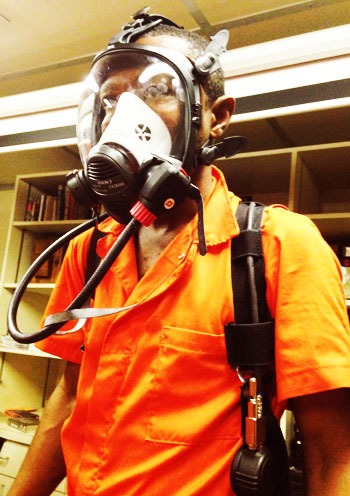+966 13 346 2511

H2S and SCBA Course
Enhance your safety skills with our comprehensive H2S & SCBA awareness course offered in Al Jubail, Dammam, and Al Khobar. This essential safety course is designed to equip participants with the knowledge and skills required to work safely in environments where hydrogen sulfide (H2S) gas may pose risks.
Course Highlights:
Understanding H2S Hazards: Gain insight into the properties and dangers of H2S gas, which is crucial for ensuring workplace safety in a variety of industries across Saudi Arabia.
Detection and Monitoring: Learn about effective detection methods and equipment that help identify H2S exposure, reinforcing proactive safety measures.
Emergency Response Training: Familiarize yourself with emergency response protocols to ensure swift and effective actions during H2S-related incidents.
Self-Contained Breathing Apparatus (SCBA): Get hands-on training on the proper usage of SCBA, essential for respiratory protection in hazardous environments.
Why Choose Our H2s and SCABA Safety Course?
Our H2S and SCBA course is tailored for those seeking safety certifications that enhance their qualifications and promote a culture of safety in the workplace. Upon completion, participants will have the confidence and competence to navigate situations involving H2S gas safely.
As a leading provider of safety courses in Saudi Arabia, we prioritize practical training combined with theoretical knowledge, ensuring that you emerge fully prepared to manage risks effectively.
Enroll now in our H2S and SCBA course in Al Jubail, Dammam, and Al Khobar, and take a significant step towards ensuring safety in your workplace!
For more information on our safety courses and to secure your spot, please contact us today.
Is H2S harmful to humans?
Yes, H2S (Hydrogen Sulfide) is extremely harmful to humans. It’s a toxic gas that can cause a range of adverse health effects, from mild irritation to death, depending on the concentration and duration of exposure.
How much H2S exposure affects your body?
The effects of H2S exposure vary greatly depending on the concentration (measured in parts per million or ppm) and the length of time exposed. Low concentrations can cause eye and respiratory irritation, while high concentrations can lead to rapid unconsciousness, respiratory paralysis, and death.
What does H2S do in the body?
H2S interferes with cellular respiration, preventing the body from using oxygen effectively. It binds to iron in the mitochondria, disrupting the electron transport chain, which is crucial for energy production. This can quickly lead to organ damage and failure.
Is H2S a poisonous gas?
Yes, H2S is a highly poisonous gas. It’s a chemical asphyxiant, meaning it prevents the body from utilizing oxygen. Even short-term exposure to high concentrations can be fatal.
Can smelling hydrogen sulfide make you sick?
Yes, even smelling low concentrations of hydrogen sulfide can cause symptoms like headache, nausea, and dizziness. The characteristic rotten egg smell of H2S is often detectable at low concentrations, but at higher, dangerous levels, it can paralyze the olfactory nerve, making it undetectable.
What to do if exposed to H2S?
If you suspect exposure to H2S:
Immediately move to fresh air.
Alert others in the area.
Seek medical attention, even if you feel only mild symptoms.
If someone is unconscious, remove them from the contaminated area and administer CPR if trained.
How do you remove H2S from your body?
The body can naturally metabolize small amounts of H2S. However, in cases of significant exposure, medical intervention is necessary. This may involve administering oxygen and supportive care to help the body recover. There isn’t a specific antidote for H2S poisoning.
What is H2S safety?
H2S safety refers to the practices, procedures, and equipment used to protect workers and the public from the hazards of hydrogen sulfide exposure. This includes monitoring air quality, using personal protective equipment (PPE), implementing ventilation systems, and providing comprehensive training.
What is a safe level of H2S?
There is no truly “safe” level of H2S, as even low concentrations can cause irritation. However, regulatory bodies have established exposure limits to minimize risk:
OSHA PEL (Permissible Exposure Limit): 20 ppm (ceiling limit – not to be exceeded at any time)
NIOSH REL (Recommended Exposure Limit): 10 ppm (10-minute ceiling)
ACGIH TLV-TWA (Threshold Limit Value – Time-Weighted Average): 1 ppm (8-hour average)
ACGIH STEL (Short-Term Exposure Limit): 5 ppm (15-minute average)
It’s important to note that these are guidelines, and individual sensitivity to H2S can vary.
What is H2S used for?
H2S has limited direct uses but is primarily encountered as a byproduct in various industries:
Petroleum Refining: Present in crude oil and natural gas.
Natural Gas Production: A common contaminant in natural gas wells.
Wastewater Treatment: Produced during the decomposition of organic matter.
Pulp and Paper Mills: Released during certain pulping processes.
Agriculture: Produced in manure pits and during the decomposition of organic materials.
What are 3 symptoms of H2S?
Three common symptoms of H2S exposure include:
Eye irritation: Burning, tearing, and redness.
Respiratory irritation: Cough, shortness of breath, and sore throat.
Headache: Often accompanied by nausea and dizziness.
What is the LEL of H2S?
The LEL (Lower Explosive Limit) of H2S is 4.0% or 40,000 ppm. This is the concentration at which H2S can form an explosive mixture in air.
What is a safe LEL level?
For safety, H2S concentrations should be kept well below the LEL. Generally, levels should not exceed 10% of the LEL (i.e., 4,000 ppm), although this is still a very dangerous concentration from a toxicity standpoint. Continuous monitoring is crucial to prevent dangerous accumulations.
How many ppm of H2S is safe?
As mentioned earlier, there is no truly “safe” level of H2S. However, regulatory bodies provide guidelines for acceptable exposure limits. Aim to maintain levels as low as reasonably achievable (ALARA principle).
Can you work in H2S up to 20 ppm without a breathing apparatus?
OSHA’s Permissible Exposure Limit (PEL) is 20 ppm as a ceiling limit (not to be exceeded at any time). While OSHA allows this exposure level, it is highly recommended to use a self-contained breathing apparatus (SCBA) or supplied-air respirator in any environment where H2S concentrations may exceed 10 ppm. The use of respiratory protection is crucial to prevent adverse health effects.
What is 1% H2S in ppm?
1% H2S is equal to 10,000 ppm. This is an extremely dangerous concentration and can be rapidly fatal.
What is a safe H2S level in confined space?
Confined spaces pose a particular risk due to the potential for H2S accumulation. Before entering a confined space, the atmosphere should be tested to ensure H2S levels are below 10 ppm and ideally as close to 0 ppm as possible. Continuous monitoring and ventilation are essential.
What is the OSHA standard for H2S?
OSHA’s H2S standards include:
29 CFR 1910.1000 (Air Contaminants): Sets the PEL of 20 ppm (ceiling).
29 CFR 1910.134 (Respiratory Protection): Requires the use of appropriate respirators when exposure limits are exceeded.
Other standards may apply depending on the specific industry and work practices.
What ppm is H2S alarm?
H2S alarms are typically set to activate at 10 ppm to provide early warning of potential hazards. More sophisticated systems may have multiple alarm levels (e.g., 10 ppm for initial warning, 15 ppm for evacuation).
Is H2S safe to breathe?
No, H2S is not safe to breathe at any significant concentration. Even low levels can cause irritation and health problems
What happens if you breathe in H2S?
Breathing H2S can lead to a variety of health effects:
Low Concentrations (1-10 ppm): Eye and respiratory irritation, headache, nausea.
Moderate Concentrations (10-100 ppm): Severe eye and respiratory irritation, dizziness, confusion, loss of consciousness.
High Concentrations (above 100 ppm): Rapid loss of consciousness, respiratory paralysis, death.
What level of H2S is toxic?
Any level above the OSHA PEL (20 ppm) is considered toxic. However, levels above 100 ppm are immediately dangerous to life and health (IDLH).
What is the first aid of H2S gas?
The first aid for H2S exposure includes:
Remove the victim from the contaminated area to fresh air.
If the victim is not breathing, administer CPR.
Administer oxygen if available.
Seek immediate medical attention.
Is smelling hydrogen sulfide bad for you?
Yes, smelling hydrogen sulfide can be harmful, even if the odor is faint. It indicates the presence of the gas, and even low concentrations can cause irritation and other symptoms.
How does your body remove H2S?
The body metabolizes small amounts of H2S in the liver. However, this process can be overwhelmed by high concentrations, leading to systemic toxicity.
Is H2S a toxic gas?
Yes, H2S is a highly toxic gas.
Where is Progressive International Training Center (PITC KSA) located?
Progressive International Training Center (PITC KSA) is conveniently located just a 10-minute drive from Jubail city center in Saudi Arabia. Our easily accessible location makes it simple for individuals and organizations in Jubail and the surrounding areas to access our world-class safety training programs.
What types of certifications and training do you offer at PITC KSA?
PITC KSA offers a comprehensive range of safety training programs, including First Aid, BLS, CPR, H2S Awareness, and SCBA training. Our certifications are aligned with the rigorous standards set by the Saudi Heart Association (SHA) and often incorporate the globally recognized guidelines of the American Heart Association (AHA).
Will I receive a certificate and card upon completion of a training course at PITC KSA?
Yes, upon successful completion of any of our training courses, you will receive a certificate and a wallet-sized card verifying your certification.
How long are the certificates and cards issued by PITC KSA valid?
The certificates and cards issued by PITC KSA are valid for two years from the date of completion of the training. This ensures that your skills and knowledge remain current and aligned with the latest industry standards.
How can PITC KSA help me or my organization with H2S safety training?
PITC KSA can provide comprehensive H2S and H2S & SCBA Awareness training tailored to your specific industry and workplace. We offer courses covering H2S hazards, detection methods, safe work practices, and the proper use of SCBA equipment. Our expert instructors, state-of-the-art facilities, and flexible training options make us the ideal partner for ensuring H2S safety in your organization.

info@pitcksa.com
Office No 202, 2nd Floor, Dana Building, King Faisal Street,
Al Jubail Saudi Arabia, 35514
